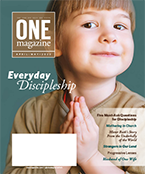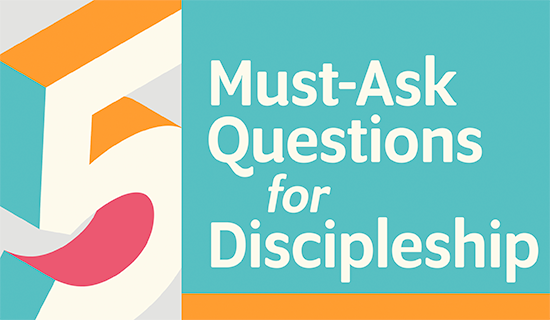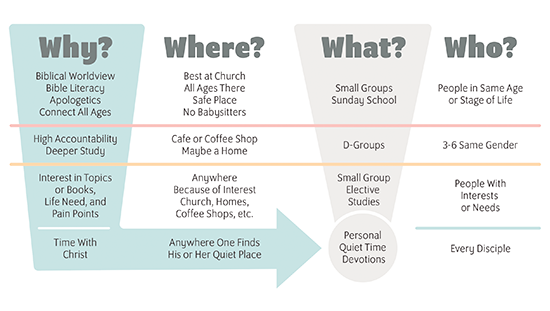
April-May 2022
Everyday Discipleship
------------------
|





Five Must-Ask Questions for Discipleship
By Ron Hunter
Every pastor desires the best discipleship approach for the congregation. Churches and contexts vary greatly based upon geography, age, socioeconomics, and other reasons. However, reality shows all churches share the same basic problems and needs. Culture shares the same problems, making the solutions less elusive. Basically, you should ask five questions when planning your discipleship strategy.
Always start with asking “why” and not “what.” Many pastors fall prey to thinking they must look toward a bigger church to model a discipleship approach. Similarly, they ask “What’s next?” thinking the next program will be the answer to the challenges. Starting with “why” forces you back to the very reason we are called to minister and reach people for Christ. Churches around the country (and the world) face the same problems: aging congregations, biblical illiteracy, lack of biblical worldview, and the loss of teens and young people as they reach adulthood.
The last problem is why the first problem exists. If churches had concentrated on keeping youth and young adults thirty years ago, congregations would not be aging. Bottom line: you cannot determine what to do without knowing what is most needed. Start with why. Simon Sinek said, “Vision is a destination—a fixed point to which we focus all effort. Strategy is a route—an adaptable path to get us where we want to go.” Our why indicates our purpose. Why (we exist) determines our how (we value certain priorities), and our how helps us select our what (activities that reflect our values and fulfill our purpose for existing).
People will more readily adopt the what when the why is clear. Remember the why frames your philosophical strategy and what forms the tactics or programs to solve or accomplish the mission or strategy.
Before going too far, let’s define discipleship. Biblically, it means passionately finding, pursuing, and living for Christ while helping others (all generations and ethnicities) do the same, which involves both reaching and teaching components in the church and at home (Matthew 28:18-20; John 15; Deuteronomy 6:4-7; Psalm 78:1-8). Dietrich Bonhoeffer argued, “Christianity without discipleship is always Christianity without Christ.”
The second question is, what characteristics matter? Research studies show four main characteristics will reduce teens walking away from their family, faith, and church. Characteristics that help kids grow into adults who love and serve Christ are: Bible engagement, sharing one’s faith, volunteering in church, and a warm, loving, involved adult nurturing
a kid’s life.
Bible engagement means helping all ages interact in and around the Word of God daily. By sharing one’s faith, you go on record as a Christian, creating accountability with peers, classmates, and colleagues while also fielding their questions and driving them back to the Bible for answers (more Bible engagement). Volunteering further solidifies commitment and growth. Finally, when adults (especially parents and grandparents) nurture biblical values and decision-making, the stickability increases exponentially.
The third question is who do we minister to? Discipleship must be done within community. People gravitate to others like themselves, forming community around common interests. Group people in communities based on needs, age, seasons of life, age of their oldest kids, marital status, and more.

With the communities identified, ask where do these communities meet? Utilize the natural gatherings of your church for intentional discipleship. You want everyone gathering for worship, but growth and connection will occur in smaller settings. Use small groups/Sunday School classes for people grouped by similar life stages and study an age-aligned curriculum that starts at church but carries over into the home. Each group must aspire to connecting all ages around the Word by teaching the same theme or topic. Then four to six adults of the same gender from their small group can form D-Groups and pursue deeper study and establish higher accountability.
Ultimately, the final group is a “group of one,” the disciple, who prioritizes personal quiet time. These layers of natural gatherings are seen in the biblical model of Jesus, who preached to the crowds (worship), taught His disciples (small groups/Sunday School), taught the inner three at deeper times (D-groups), and commanded individual disciples to “watch and pray” (quiet time).
The debate continues over meeting in the church or home (which may include coffee shops, etc.). Which is better? The answer, YES to both, but again knowing why each location works. For some non-Christ followers, meeting at a coffee shop is safe, less threatening, and perhaps more convenient. The same convenience may apply to regular church members, but you still expect attendance at weekly worship services.
Why ask everyone to come to two events at two different locations when you can extend the time of one event to combine discipleship and worship in small group and church service in one location and one calendar event?
In a day when people are reluctant to visit other homes or host guests for safety/liability reasons, the church offers many advantages: appropriate options for kids, enough chairs (including right size chairs), tables, restrooms, and built-in supervision because all ages meet at the same time.
It almost goes without saying, the young adults of every generation own “the cool factor.” They can easily gather in homes or coffee shops, but that all stops when they have children themselves. Or, they tend to stay in a close circle of friends that prohibits reaching new people. The layers of discipleship graphic above shows suggested meeting types, locations, and participants based on discipleship maturity level as discussed in the next question.
Fifth and finally, which model works best? Four family ministry or generational discipleship models are taught by major Christian universities and seminaries: The D6 model, the integrated model, the adoptive model, and the milestone model. The D6 model, named after Deuteronomy 6:4-7, teaches generational discipleship through church and home. The church, through age-specific ministries, equips parents to continue discipling their kids daily with connections around the lessons started at church. The integrated model seeks the same as the D6 model but removes all age-specific ministries (Sunday School, youth groups, and children’s ministry) by keeping all ages together in worship and one big class. The adoptive model has more mature Christians adopting or mentoring the younger or less mature. Finally, milestones recognize key benchmarks in a child’s development such as birth, going to school, accepting Christ, baptism, getting a first cell phone, purity talks, driver’s license, graduation, and ultimately becoming an active adult church member. The key to milestones is the celebration of these events while preparing parents to navigate and model biblical values leading into each milestone.
Which model works best? Ideally, layering all of them through a focus on seasons (milestones), weekly at-church mentoring across generations and from teachers and volunteers (adoptive), and the foundation of age-aligned lessons in church and aligned daily devotions for regular faith conversations in the home. There is a place for integration as well, with combined worship services for everyone—not just the little ones joining the adults. Plus, integrated activities like service projects, mission trips, and similar foster adoptive relationships, with parents serving alongside their kids.
Studies show the major factors in kids reaching adulthood and sticking with their faith include regular time in Scripture, sharing their faith, and having an involved, caring adult helping develop their faith. The what that is taught and what we do should always complement the why, informing your choice of what.
Foundationally, all ages study the same lesson using a planned curriculum like D6. Putting every age on the same page sets families up for helpful conversations and application by parents and grandparents at home, where life happens, and instruction is needed. The what supports the why. But, if everyone writes his or her own curriculum, or if some groups study the sermon and others something different, no connected conversations can easily take place in the home.
D6 provides biblical literacy and includes biblical worldview teaching with everyday conversations and life applications. D6 equips families for home discipleship with age-aligned devotional studies, encouraging and discipling them in the deepest level of individual discipleship habits. Doing so makes it easy to have a caring adult studying the same material, and helping apply those lessons to everyday life.
The why you teach must answer the research, the what solves the issues all congregations face, and builds your comprehensive strategy to make a generational difference.
About the Author: Since 2002, Ron Hunter Jr., Ph.D. has served as executive director and CEO of Randall House & D6 Family Ministry. He pastored 11 years before starting his present role. Hunter has five published books and is passionate about leadership and discipleship.
|
|

